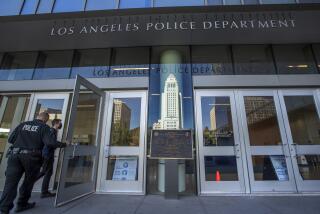Pena shooting blamed on lack of supervision
- Share via
New details released Tuesday indicate the standoff that led to the LAPD shooting of 19-month-old Suzie Pena was marked by a lack of proper supervision, resulting in officers firing toward one another and into a building where the child was being held by her father.
The Los Angeles Police Commission announced last week that of more than 30 officers at the South Los Angeles car shop, only two violated department policy at the start of the 2 1/2 -hour standoff.
It also found that a lieutenant, three sergeants and 13 officers needed more training.
Last week, the panel cleared SWAT officers who stormed the building at the end of the standoff, but indicated that there were “command and control” problems during some parts of the siege.
The elaboration came in the 21-page summary of the commission’s findings released Tuesday. The summary paints a picture of a hostage situation in which poor communication and a dearth of leadership early in the incident caused some officers to mishandle it.
The commission concluded that “because of limits of command and control during this incident, subordinate officers assumed leadership roles, implemented tactics that were not coordinated and ultimately fired into a building where it was known at least one hostage was being held.”
The July 2005 incident began when officers responded to a radio call of “unknown trouble.”
Jose Raul Pena began firing at officers while holding his daughter and retreated into a small building on the car lot.
The incident ended when SWAT officers stormed the office, killed the father and discovered that the daughter, shot in the head, had died as well.
LAPD officials said a bullet from a police rifle probably killed the girl, but were unable to determine which officer fired the shot.
Luis Carrillo, an attorney representing Suzie Pena’s mother in a lawsuit, said the report issued Tuesday confirms what he has suspected.
“This goes along with the concern that there was a breakdown of command and control by supervisors,” Carrillo said.
Without proper field supervision, police set up at the back and front of the auto sales lot so that some of them were caught in a crossfire from fellow officers, the report concluded.
“When officers came under fire and returned fire, their rounds penetrated through the building, causing officers ... to believe they were under fire from” Pena’s father, the report said.
The commission and Police Chief William J. Bratton included recommendations for changes in training and policy to address the command failures. Citing state privacy laws, the summaries identify the 31 officers and supervisors only by letters.
One of the officers who was found to have violated department policy in firing his weapon told investigators he returned fire after seeing Jose Pena shooting at him, but the commission said: “Evidence demonstrated that Officer G could not have seen [Jose Pena] at this time” and the “investigation established that the rounds impacting near Officers G and L were those of the officers in front of the lot firing at [Jose Pena] during their attempts to rescue” his daughter.
Another officer, on the job for seven years, “could not have seen” Jose Pena, “and fired without a target” even though he “knew that hostage(s) were present and showed disregard for their safety,” the report said.
The panel also “noted that Officer L knew that other officers were positioned on the opposite side of the lot and were potentially in his line of fire.”
The commission followed the recommendations of Bratton, who found that video from a security camera system contradicted the two officers’ claims.
*
More to Read
Sign up for Essential California
The most important California stories and recommendations in your inbox every morning.
You may occasionally receive promotional content from the Los Angeles Times.












